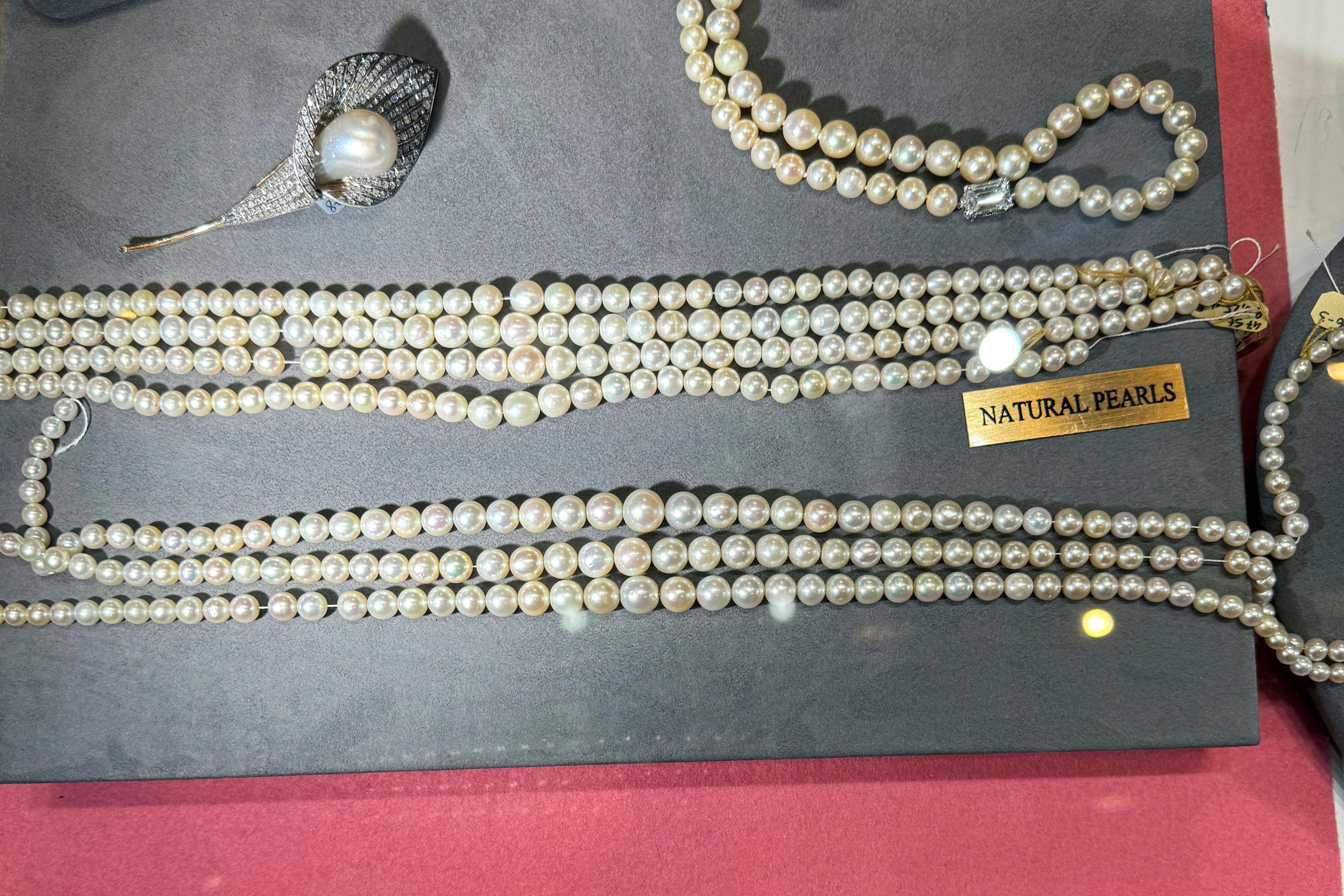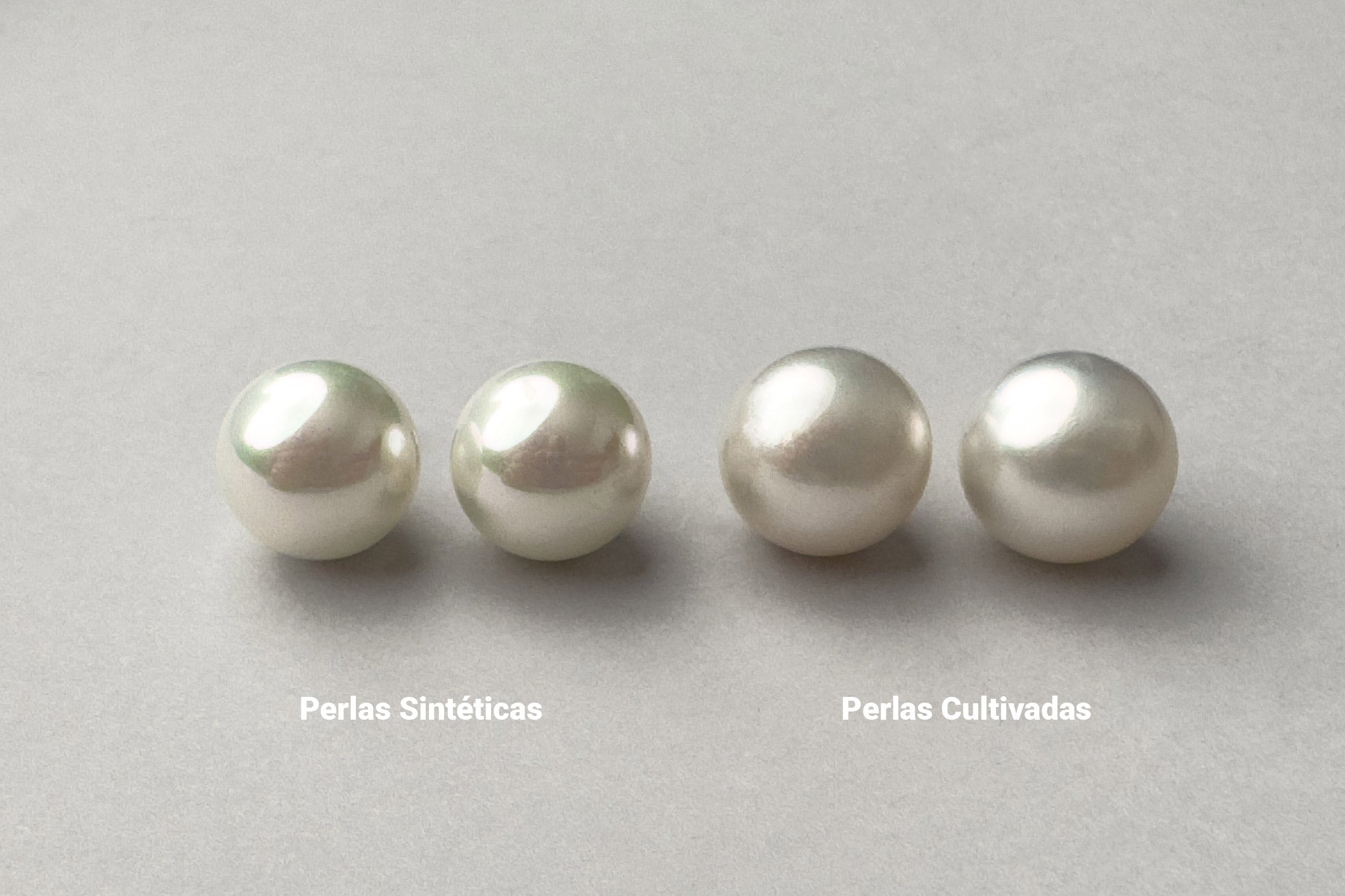Article: Natural, cultured and synthetic pearls, what is the difference?

Natural, cultured and synthetic pearls, what is the difference?
The world of pearls may seem simple from the outside, but it is more complex than one might imagine.
There is a lot of contradictory and unprofessional information that has caused a certain lack of knowledge, but don't worry, in this article we are going to clarify all these doubts.
As you can see, we have three very distinct groups of pearls: natural pearls , cultured pearls , and synthetic, fake or imitation pearls .
Let's start at the beginning.
What is a natural pearl?
Natural pearls are gems that form completely spontaneously and without human intervention, inside marine mollusks, such as oysters and mussels.
Pearls, like the shells of oysters and mussels, are made of nacre or mother of pearl , which in turn is composed of calcite , aragonite and a protein substance known as conchiolin.
There are many myths and hoaxes about how a pearl is formed in nature. Probably the most famous is the grain of sand myth. The theory is that a grain of sand or other object gets inside the oyster, irritating it and causing a defensive reaction that causes the secretion of nacre to encapsulate the invader.
Well, this theory is completely false .

Strands of natural pearls on display at the Hong Kong International Jewelry Fair in 2024
Other mussels do not have the ability to feel irritated, in fact, they are not even capable of feeling , since they do not have a brain per se. They have a very simple nervous system, which allows them to perform basic functions, such as eating, growing and reproducing. In this sense, they are more similar to a plant than to an animal.
The reality is that a pearl is formed when the epithelial cells found in the mantle of the oyster are displaced to another location within the oyster.
For example, it is possible for a parasite to pass through the oyster shell, through the mantle and reach the gonad , dragging epithelial cells along with it. The only function of these cells is to generate nacre so that the oyster grows, so they will continue to fulfill their function despite having been displaced. When they are inside the gonad, what is known as the “pearl sac” is formed, which is gradually filled with layers of nacre, until it forms a pearl that is usually more or less spherical in shape, but not necessarily round; in fact, round pearls are the rarest and most difficult to obtain.
As you can see, this is a completely accidental and complex event, which is why finding a natural pearl is so complicated. It is estimated that only in one in ten thousand oysters can a natural pearl of a moderately acceptable quality be found.
What is a Cultured Pearl?
Cultured pearls are pearls created by oysters and mussels, but with the help and care of humans .
It is important to clarify that what you see in jewelry stores today are all cultured pearls . As we have already explained, natural pearls are extremely rare and are reserved for collectors or people with very high purchasing power, since a simple natural pearl necklace can cost millions of euros. In addition, since the invention of plastic, oysters were no longer sought to create mother-of-pearl objects, such as buttons and ornaments. Pearls were still an extra product of the mother-of-pearl industry , and with the invention of pearl cultivation at the beginning of the 20th century, the natural pearl industry practically disappeared.
Saltwater pearl cultivation was discovered by a Japanese entrepreneur named Kokichi Mikimoto who, after a decade of attempts, managed to cultivate the first crop of complete Akoya pearls in 1916 , years before he had managed to cultivate half pearls.
Visit our collection of Akoya pearl jewelry here.
The method that Mikimoto discovered is the one that is still used today .
After about three years of caring for the oysters, until they reach a size suitable for producing a pearl, the oysters are removed from the water to carry out the nucleation process .
The process consists of two steps. First, the shells are separated from each other by a few millimetres and a nucleus, a small ball made from the shell of another oyster or mussel , is introduced . The second step is the introduction of a small piece of the mantle of a donor oyster . This small piece of mantle contains the epithelial cells mentioned above. If the operation is successful, the oyster is returned to the water for a period of between one and two years , sometimes a little longer, depending on the type of oyster. During these two years, the oysters are cared for by the producers and if all goes well and natural disasters , red tides, water temperature and other threats allow it, a beautiful cultured pearl can eventually be extracted.

Worker inserting a nucleus into an Akoya oyster
Thanks to this process, the chances of obtaining quality pearls increase significantly, however, only a small percentage of the pearls harvested will have adequate quality . On the other hand, by including a round nucleus inside, the chances of obtaining a round pearl also increase, but even so only 20 or 30% of the pearls harvested are round.
There is one exception to the cultivation method, which is freshwater pearls , which are created by mussels . In this case, no nucleus is included, only a piece of tissue from a donor mussel, making it more difficult to obtain round pearls . However, in recent years, scientific and technological advances have allowed for improved cultivation methods for freshwater pearls, and some freshwater pearls with nuclei are now being cultivated.
Finally, it is worth mentioning that there are different types of cultured pearls. On the one hand, we have saltwater pearls : Akoya pearls, South Sea pearls and Tahitian pearls. And on the other hand, we have freshwater pearls : classic freshwater pearls and freshwater pearls with a core .
Visit our collection of jewelry with Freshwater Pearls Here
You can learn all about the different types of pearls in our guide.
What is a synthetic pearl?
Simple, synthetic pearls are not pearls , they are objects created in a factory , which try to imitate a pearl. The most typical materials are glass , shells and plastic .
One of the most famous imitation pearls out there is the Majorca pearl or Majorica pearl, created with a glass core and varnished with an organic compound. You can read more information about these pearls here.
How to tell if a pearl is fake?
There are several methods to tell if a pearl is real or fake, but today we will focus on the two simplest ones.
The first is to lightly rub two pearls against each other . If you notice a rough feel and even see a slight dust build-up, they are most likely cultured pearls. If they slip a lot, they are fake pearls.
 In this case, you can see that the synthetic pearls are very large, typical of a South Sea pearl, but their shine is too "mirror-like" while South Sea pearls usually have a silkier shine. This allows us to identify that they are an imitation, with a simple glance.
In this case, you can see that the synthetic pearls are very large, typical of a South Sea pearl, but their shine is too "mirror-like" while South Sea pearls usually have a silkier shine. This allows us to identify that they are an imitation, with a simple glance.
The second method is the tooth method. Simply slide the pearl gently along one of your upper teeth (no need to bite down). If it feels gritty , like sandpaper , it's most likely a cultured pearl. If it feels very smooth and slippery, it's probably an imitation.
You can also look at the temperature , cultured pearls tend to be cooler to the touch.
Furthermore, cultured pearls are not perfect , even if they are of very good quality. They are never completely spherical and have a surface that is completely free of imperfections. In the case of designs with several pearls, they are never completely identical to each other. However, imitation pearl manufacturers already create pearls with imperfections to give them a more realistic appearance, so the methods mentioned at the beginning are more accurate.
Now that you know the different types of pearls, visit our online store, where you can find the perfect cultured pearls for you. And don't hesitate to contact us if you have any questions.





